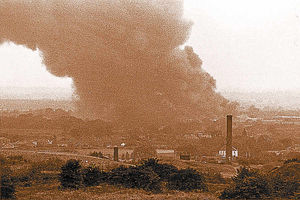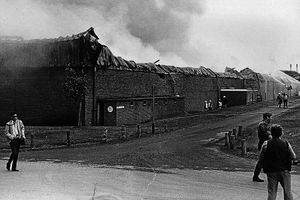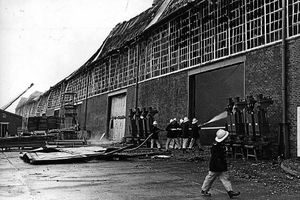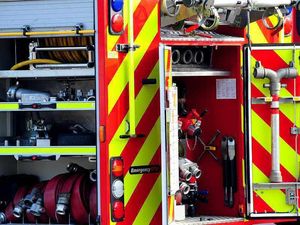Shropshire woman's asbestos death linked to 1983 COD Donnington fire
A woman's death has been directly linked to contact she had with asbestos in the aftermath of a devastating fire in Telford more than 30 years ago.

Paula Ann Nunn died from a lung disease after inhaling dust from the fire that broke out at COD Donnington when she was in her thirties.
She died in September from mesothelioma, a cancer caused by exposure to asbestos.
The fire at COD Donnington in 1983 sent a huge plume of smoke, debris and dust high into the Shropshire skies. Mrs Nunn was exposed to ash containing asbestos when it fell in the garden of the home she lived in at the time.

In the immediate aftermath of the huge fire at COD Donnington in 1983, there was extensive fallout of pieces of asbestos from the roof, carried high into the air by the smoke and flames, and deposited on the surrounding landscape.
There was a clear up by council workers wearing what looked like space suits. But now we are facing a different sort of fallout.
In September, Paula Ann Nunn died of mesothelioma, a form of cancer caused by exposure to asbestos. Back in 1983 asbestos came down in her garden.
Now an inquest has directly linked her death to contact with that asbestos. It is the second death to be directly linked to the same cause. And Shropshire coroner John Ellery expects there to be further cases.
This will be a matter of grave concern for everybody who was affected by this deadly dust at the time. The numbers are difficult to judge, but we could potentially be talking of hundreds of people, perhaps even thousands.
It is a ticking time bomb. Mesothelioma, which affects the tissue covering the lungs, develops many years – usually between 20 and 60 years – after the initial exposure.
It is almost always caused by exposure to asbestos, so when people with no other form of past exposure develop the disease, then their contact with the asbestos fallout of the 1983 fire will be the prime suspect, or only suspect.
The extraordinary thing about the 1983 fire was that you would think that lessons would have been learned, but they spectacularly were not, because in 1988 the sister building of the blitzed 1983 warehouse also caught fire. Once again, asbestos from the roof was carried miles in the massive smoke cloud to rain down on housing estates, farms, villages and countryside. Council chiefs advised people in the path of the debris to keep doors and windows closed.
Together, the two fires cost taxpayers well over £300 million at today's prices, but from the health point of view the absence of any consequences for so long gave a false impression, that Shropshire got away with it.
Tragic as the two deaths are, we have to hope that they are isolated cases. However, it is not scaremongering to make an assessment that there may be others, and that the nature of mesothelioma means there could be cases related to the Donnington fires into the middle of the 21st century.
What a dreadful legacy.
The 68-year-old, of Newport Road in Edgmond, died at the Severn Hospice in Apley on September 18.
An inquest heard that when the Army storage warehouse caught fire, ash containing asbestos was scattered over a 15 square mile area.
Neighbouring houses were completely covered with the ash, which remained on gardens for an extended period.
Mrs Nunn's death is the second to be linked to the fire. In 2008, it claimed its first victim when mesothelioma sufferer Ellen Paddock died aged just 31.
Before her death, Mrs Nunn had told been in contact with Asbestos Support and had told workers about how ash from the fire fell into her garden. In a statement read out by Shropshire Coroner John Ellery, he said: "For two days there were no warnings that the dust was dangerous and by this time a lot had accumulated over the local area in particular in Mrs Nunn's back garden."
Mrs Nunn's death was recorded by Mr Ellery as accidental death. He pledged to keep the file on COD Donnington constantly open as he expected more cases in the future.
It was initially denied the ash contained asbestos and it remained in the streets for five days before the clean-up operation began.
But that was too late, the damage had been done.
In April 2008, Mr Ellery presided over an inquest, alongside the then Telford & Wrekin coroner Michael Gwynne, into the death of Ms Paddock. It was linked to the 1983 fire, one of two major blazes at the Donnington site in the 1980s.
Mr Ellery said: "This was all related to the first fire, although there was a very similar fire a few years later.
"At the time Ms Paddock was very small and described seeing snowflakes falling and playing in the snowflakes.
"Tragically they were not snowflakes, they were asbestos and some 25 years later Ms Paddock died of mesothelioma.
"Mrs Nunn's case is sadly similar to that regarding Ms Paddock. The only difference there was that her father worked with asbestos some distance away and could have carried it home on his overalls, but it was decided that played no part.
"Had she died from work related to her father it would have been recorded as industrial disease.
"However, as it was from asbestos in the air it was accidental death.
"It has been established that mesothelioma is almost always caused by exposure to asbestos.
"I will base my verdict both on what Asbestos Support have told me and what was recorded in 2008."
Mr Ellery was asked questions about what precedent Mrs Nunn's case will have on future cases of mesothelioma.
Mr Ellery said: "These have set a precedent which has been spread to coroners about what was released in the fire.
"By way of assurance to you about Mrs Nunn's case, I keep the file on COD Donnington constantly open to add in any links from any future cases come forward.
"Any lessons will be added to the main file.

"This is the second death in Shropshire that is clearly attributed to the fire. I have been Telford & Wrekin coroner as well as Shropshire Coroner since 2009 and this is the second case which is clear, of a non-employee being exposed."
There have been dozens of cases worldwide in which mesothelioma has been linked to asbestos in ash following fires.
The most notorious is the case of Marcy Borders, who became known as the 'dust lady' after the New York Twin Towers attack on 9/11. The former Bank of America employee was captured in an iconic image covered in dust from the attack in 2001. She died in August of this year aged 42, her case just one of several that have already emerged among survivors and firefighters who were at the scene of the attack.
Mrs Paddock, a mother-of-three, launched legal proceedings against the MoD because of her illness.
At the time of the inquest, her mother Mary Bush, said: "She lost all those years off her life that she could have had for her and her girls."
She said people needed to know just how dangerous the dust from the fire was, adding: "All the kids were in it. People have got to know about this and how dangerous this is."






